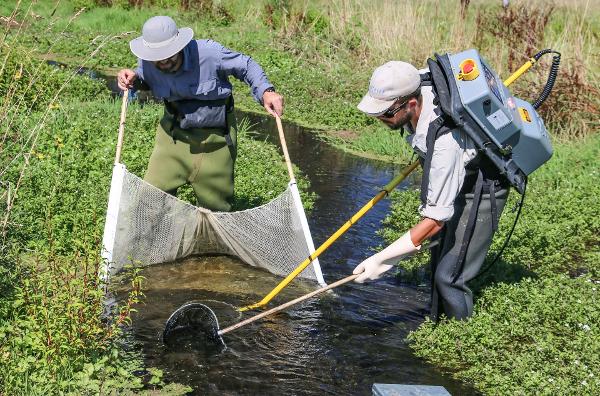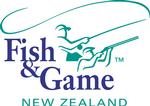Fish & Game scientists research New Zealand's rivers with electric fishing technology

The effects of barriers to fish passage on native species and trout in Taranaki, and a recovering kōaro and eel population in Nelson/Marlborough are among the insights gained in an electric fishing research programme carried out by Fish & Game.
Fish & Game teams in regions including Otago, Central South Island, West Coast, North Canterbury, Nelson Marlborough, Wellington and Taranaki have been sweeping rivers and streams with a pole that emits a low-voltage, high-current charge.
Fish drawn towards the charge are stunned temporarily and scooped up in a net. They are identified, weighed, and measured before being returned to the water.
The electric fishing programme helps Fish & Game monitor populations of trout and salmon, but also record native freshwater fish such as various species of galaxiids, koaro, kokopu, bullies, eels, torrent fish, lamprey and koura.
They also note waterway condition, macroinvertebrates, and barriers to fish movement.
Data is entered into NIWA’s New Zealand Freshwater Fish Database for use by other freshwater scientists and to inform both regional and national policy.
In Taranaki, electric fishing surveys are monitoring the effects of barriers to fish passage for native species and trout, and have highlighted a decline in water and habitat quality that occurs down the length of ringplain catchments.
Meanwhile, Fish & Game staff in Nelson and Marlborough, with assistance from DOC staff, are tracking a recovering koaro and eel population after native fisheries were annihilated by Cyclone Gita in 2018.
Staff in the region have also found increased climate-change generated floods pose just as much, if not more, risk to native fish populations as they do to trout.
"Electric fishing is helping to protect New Zealand’s freshwater fish and rivers," says Corina Jordan, chief executive of Fish & Game.
"It may sound unusual but it’s an effective way to keep watch on the state of our fish species, including indigenous populations, and the places they live.
"These surveys support other research that show native fish populations, as with juvenile trout, are at risk from the increased frequency and size of flooding."
"Monitoring identifies waterways with declining water and habitat quality, and the effects of barriers to fish passage.
"This important programme also sees Fish & Game staff connecting with local communities, land owners and partners."
In Hawke’s Bay, Fish & Game staff plan to partner with other local agencies and iwi to resume electric fishing in small streams before Cyclone Gabrielle brought the monitoring programme to a halt.
Before Gabrielle swept in, Fish & Game in Nelson and Marlborough region was already tracking the recovery of native fish populations affected Cyclone Gita in 2018.
Under the Resource Management Act, the management of physical resources must have regard to the protection of the habitat of trout and salmon.
Fish & Game mostly uses electric fishing to confirm the presence of juvenile trout, a marker of successful spawning.
"Because juvenile trout stay within the stream their parents spawned in, any observation proves that trout spawning occurred somewhere within the reach or further upriver," Jordan says.
"The presence of trout means Fish & Game can advocate for that habitat, which benefits all aquatic life ─ native and valued introduced species."
Electric fishing is also used to educate school and catchment groups about stream habitat and health.
Fish & Game also shares data with agencies such as the Department of Conservation for resource consents and partners with universities on electric fishing monitoring projects.
"As river guardians, Fish & Game has been gathering and sharing data for over 30 years and will continue monitoring in future for the benefit of all freshwater fish species," Jordan says.
ENDS
SNAPSHOT: ELECTRIC FISHING AROUND THE REGIONS
Hawkes Bay: Staff conducted electric fishing in small streams before Cyclone Gabrielle brought monitoring to a halt. There are plans to combine resources with other local agencies and iwi to resume electric fishing surveys in that region.
Taranaki: Electric fishing surveys have highlighted the effects of barriers to fish passage for native species and trout, and shown the decline in water and habitat quality that occurs down the length of ringplain catchments. Fish populations in Timaru Stream are being studied before and after removal of a weir. Following major flooding of Waiaua Stream, surveys found native redfin bullies and juvenile trout in tributaries, and juvenile eels recolonising the badly affected mainstem.
Wellington: Systematic electric fishing surveys during summer capture the presence of juvenile trout in reaches not subject to drift dive surveys, shedding further light on trout spawning and habitat. Juvenile trout have been found in 76 rivers and streams across all major catchments. Since Cyclone Gabrielle, Fish & Game staff are looking at survivorship of juvenile trout to get a better idea of what recruitment might look like next year. Used as one measure of overall stream health in the region. Staff are astounded at the diversity of indigenous fish found within trout spawning waters, proving the work done to protect trout habitat is of real value to native species too.
Nelson-Marlborough: Fish & Game electric fishes three river systems each summer to assess the health of native fish populations after past adult trout releases aimed at rebuilding flood-damaged salmonid fisheries. Staff have found increased climate-change generated floods pose just as much, if not more, risk to native fish populations. Staff are tracking a recovering koaro and eel population after native fisheries were annihilated by Cyclone Gita in 2018. Monitoring of other native fish includes dwarf and northern galaxiid and threatened migratory shortjawed kokopu.
West Coast: Staff electric fish Mawheraiti River tributaries annually, and recently began surveying New River. Data is occasionally shared with the Department of Conservation for resource consents.
North Canterbury: This summer Fish & Game surveyed habitat for endangered Canterbury mudfish, and staff have been on standby to salvage fish when rivers dry up due to drought, overextraction and irrigation system maintenance.
Central South Island: Electric fishing monitors salmon smolt, trout and native fish in New Zealand’s most complex and largest fish screen system in the Rangitata Diversion Race. Staff survey catchments extensively finding native fish "almost everywhere" along with sportsfish, suggesting co-existence of valued introduced species and native fish is a sustainable ecological reality.
Otago: Staff electric fish survey 20-30 rivers and streams annually. This summer they included the Shag/Waihemo River, lower Clutha River/Mata-Au tributaries, the Catlins and Owaka rivers, Waters of Leith, Lindsays Creek, Silverstream, Kaikorai Stream and Thompson Creek. Electric fishing is also used to educate school and catchment groups about stream habitat.
Southland: Electric fishing is used to monitor fish populations and spawning success. It also contributes to the New Zealand Freshwater Fish Database that can provide insight into native fish populations and their distributions.
